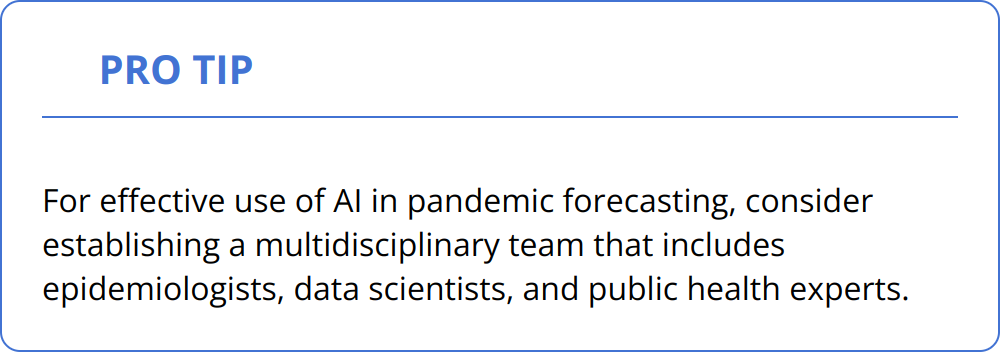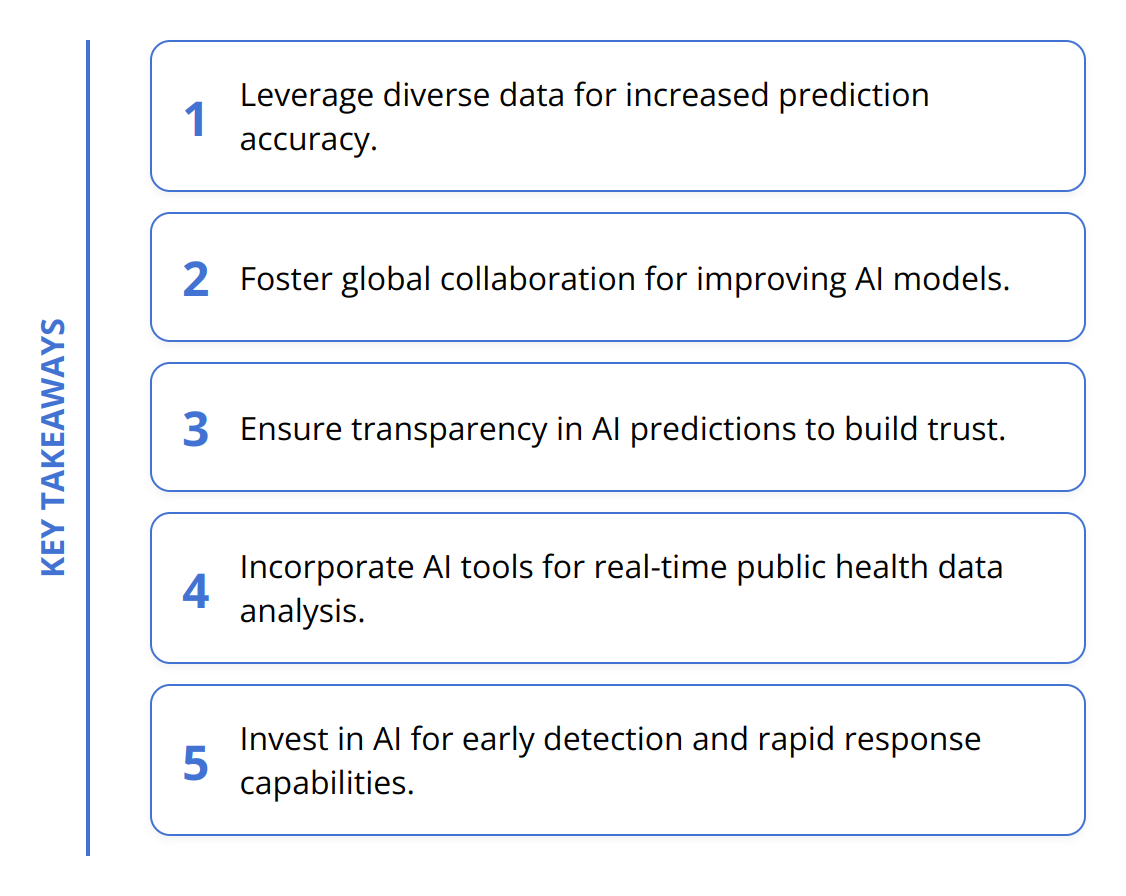Artificial Intelligence (AI) is proving to be a game-changer in the way we predict and manage pandemics. We’ve witnessed firsthand the evolution and integration of AI in public health strategies, particularly in pandemic prediction. This guide aims to shed light on the future of AI in forecasting outbreaks, enhancing the accuracy of predictions, and ultimately, saving lives. Through real-world case studies and data analysis, we will explore how AI technologies are transforming the landscape of public health.
AI in Pandemic Forecasting
Artificial Intelligence (AI) has transformed the way health experts predict and manage pandemics. The power of AI to analyze vast datasets swiftly allows for accurate forecasting, which is fundamental in preventing widespread disease outbreaks. This capability is not only a testament to technological advancement but also a beacon of hope for better preparedness and response in future health crises.
AI’s role in pandemic prediction is not new; it has been evolving over the years. Historically, AI has assisted in detecting patterns and anomalies in data that could indicate the emergence of a disease. For instance, AI algorithms have been used to analyze health reports, social media posts, and travel data to predict the spread of diseases like influenza. These technologies have grown more sophisticated, offering more precise predictions and enabling authorities to take timely action.
The significant role of AI became more pronounced during the COVID-19 pandemic. AI technologies played a critical role in forecasting outbreaks, estimating the virus’s spread, and understanding its behavior. For example, AI models were crucial in predicting the peaks of infection waves, aiding governments in predicting the outcomes of lockdowns or social distancing measures limited to the accuracy of the data. Moreover, AI-driven tools supported the development of diagnostics, treatments, and vaccines at an unprecedented speed.
Here are a few actionable insights to harness AI in pandemic prediction:
- Utilize and ensure accurate data at regular intervals with clear and concise definitions for each data field shared across all data sources.
- Integrate diverse data sources: Combining healthcare data with travel, social media, and environmental data enhances the accuracy of AI predictions.
- Foster collaboration: Sharing knowledge and data among countries and organizations can improve AI models’ effectiveness.
- Prioritize transparency: Clear communication about how AI models make predictions can build public trust and compliance.

AI in pandemic prediction is a vital asset, offering the potential to save lives by providing early warnings and enabling swift responses. As technology continues to evolve, AI’s role in public health is expected to grow, offering even greater capabilities in the fight against future pandemics.
Early AI Detection Benefits
Artificial Intelligence (AI) reshapes how we identify and respond to pandemic threats before they escalate. Its ability to sift through extensive data sets, identify patterns, and predict outcomes far surpasses traditional methods. The most significant advantage of AI in early detection and prediction includes enhanced predictive accuracy, dynamic data analysis, and rapid response facilitation.
The Power of AI in Data Analysis
AI excels in analyzing complex data patterns that are often invisible to the human eye. It can integrate and assess data from a multitude of sources, including health records, social media, and environmental indicators. This comprehensive analysis allows AI to detect potential outbreaks much earlier than conventional methods. For instance, AI systems can identify increases in related search terms or social media posts that often precede official outbreak reports. By doing so, AI serves as an early warning system, flagging potential threats before they become evident through traditional reporting channels.
Ensuring Predictive Model Accuracy
The accuracy of predictive models is paramount, especially when it comes to public health. AI significantly enhances this accuracy by constantly learning from new data. As more information becomes available, AI models adapt, improving their predictions. This is critical because it allows health authorities to make informed decisions based on the most accurate and current data. Models that predicted the spread of COVID-19, for instance, have been updated with real-time data, offering precise forecasts that inform proactive measures. Such accuracy is vital for allocating resources, planning for hospital capacities, and implementing prevention strategies effectively.
Accelerating Response to Threats
One of AI’s most notable contributions is its ability to speed up the response to emerging threats. Time is of the essence in controlling pandemics, and early intervention is key to minimizing impact. AI systems can process vast amounts of data in real time, offering immediate insights that can inform swift action. Whether it’s implementing travel restrictions, starting vaccine development, or enhancing public health campaigns, AI-driven insights help accelerate responses, potentially saving thousands of lives.

Key Takeaways
- Data Quality: Ensure shared lexicon and reporting frequency is key to accurate conclusions.
- Data Integration: Leveraging diverse data sources increases prediction accuracy.
- Continuous Learning: AI models that adapt with new data become more precise over time.
- Expedited Actions: Quick, informed decisions can drastically reduce a pandemic’s impact.
The ability of AI to anticipate pandemics and influence early interventions marks a paradigm shift in public health. Its role in predicting, detecting, and responding to threats highlights the evolution of technology as a cornerstone in healthcare strategy. As we continue to refine these AI systems, their potential in safeguarding against future pandemics will only increase.
AI in Pandemic Prediction: Case Studies
Artificial Intelligence (AI) has revolutionized pandemic prediction and management by providing accurate forecasts that greatly influence public health decisions. Real-world applications of AI in predicting outbreaks like COVID-19 have demonstrated its powerful capability to handle public health crises. This chapter explores practical instances where AI significantly improved early detection and preparedness.
AI’s Role in Predicting the COVID-19 Outbreak
In the early days of the COVID-19 pandemic, AI systems outpaced traditional detection methods by analyzing vast data. Researchers used machine learning to sift through news reports, airline data, and disease outbreaks to identify patterns indicative of a new virus. A notable example is BlueDot, a Canadian health monitoring platform, which flagged the outbreak days before the World Health Organization announced it. This early detection allowed for quicker responses, though global preparation was still challenging. The lesson here is clear: AI technology can detect emerging threats rapidly, offering precious time to react.
- Practical Tip: Incorporate AI monitoring tools in public health strategies for real-time data analysis and threat detection.

Other Notable Instances Where AI Aided in Early Detection
AI’s potential isn’t limited to COVID-19. Its applications have been crucial in identifying and managing other disease outbreaks. For instance, AI systems successfully predicted the spread of the Zika virus by analyzing climate data, population density, and travel patterns, demonstrating the power of integrating diverse datasets for disease forecasting. In another example, AI algorithms monitored social media platforms to detect the early spread of Ebola, showcasing the unconventional yet effective data sources for early warning systems.
The successes of AI in these scenarios emphasize the importance of preparing and investing in AI technologies for future public health challenges. Governments and health organizations must prioritize the development of sophisticated AI tools that can analyze diverse data sets for more accurate predictions.
- Actionable Insight: Invest in diverse data collection and AI modeling to enhance early detection capabilities.
The application of AI in pandemic prediction showcases its invaluable role in enhancing public health responses. By learning from these case studies, it’s evident that AI not only aids in early detection but also in the preparation and management of global health emergencies. The key is to leverage AI’s capabilities to integrate and analyze diverse data sets for proactive pandemic response strategies.
Final Thoughts
Artificial Intelligence (AI) has demonstrated its value in transforming pandemic prediction and public health responses. AI’s ability to analyze vast quantities of data rapidly, identify patterns, and forecast outbreaks before they escalate has proven indispensable. These capabilities have not only improved the accuracy of predictions but also accelerated responses to public health threats, saving countless lives in the process.

Looking ahead, integrating AI into public health strategies heralds a new era of preparedness and responsiveness to global health crises. The successes we’ve seen, particularly during the COVID-19 pandemic, underscore the potential for AI to serve as a cornerstone of future public health initiatives. As AI technologies evolve, their role in detecting, managing, and potentially averting pandemics is expected to grow, marking a paradigm shift in how we approach global health security.
However, the journey doesn’t stop here. The advancements in AI technologies present an ongoing challenge and opportunity for researchers, policymakers, and public health officials. Encouraging further research and development in AI is beneficial and necessary to harness its full potential. Investing in AI research will enable us to refine current models, explore new applications, and, ultimately, pave the way for more resilient healthcare systems.
We at FutureWave Research are exploring how advanced technologies like AI can redefine industries and improve societal outcomes. We believe technology can drive positive change, and AI’s role in public health is a prime example of this conviction. Through our insights and consulting services, we aim to equip our clients with the knowledge and tools they need to succeed in this new technological era.
As we continue to navigate AI’s challenges and opportunities in healthcare, we invite you to join us on this journey. Understanding and leveraging AI’s capabilities will be key to shaping a future where technology and public health work together to create a safer, healthier world for all. Subscribe to our newsletter for more insights into the world of technology and its impact on society.
In conclusion, AI’s impact on pandemic prediction is a testament to the transformative power of technology in public health. Looking to the future, AI will play an increasingly vital role in safeguarding global health, but it will be up to us to implement it in a non-partial, apolitical system. By fostering further research and development in AI technologies, we can continue to improve our preparedness for future pandemics and make strides towards a healthier future for communities worldwide.

